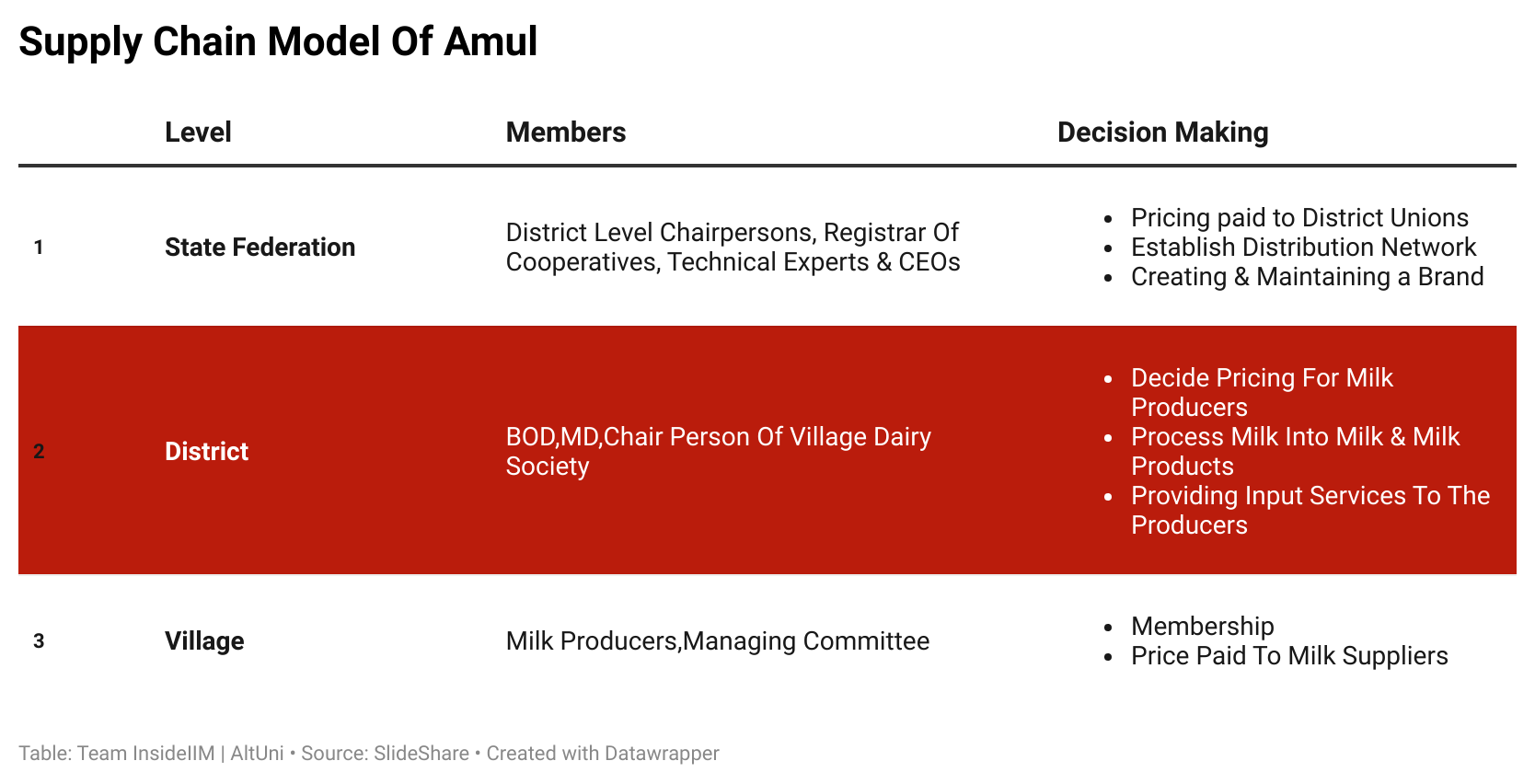Problem Statement:
Initially, the producers had to travel long distances to deliver milk to the only dairy, the Polson Dairy in Anand – often milk went sour, especially in the summer season, as producers had to carry milk in individual containers physically. These agents decided the prices and the off-take from the farmers by the season. In winter, the producer was either left with unsold surplus milk or had to sell it at very low prices.
The Establishment Of Amul
Thus the Kaira District Cooperative was established to collect and process milk in the district of Kaira. The first modern dairy of the Kaira Union was established at Anand “which popularly came to be known as AMUL dairy after its brand name”. The new plant had the capacity to pasteurize 300,000 pounds of milk per day, manufacture 10,000 pounds of butter per day, 12,500 pounds of milk powder per day, and 1,200 pounds of casein per day.
The model of Amul is such that it benefits small producers like farmers, who together form an integrated approach to form an economically large-scale business. The model eliminates middlemen, bringing producers in direct contact with the customers.
Every day, Amul collects 447,000 litres of millk from 2.12 million farmers, converts the milk into branded, packaged products and delivers the goods which are worth Rs. 60 million to about 500,000 retail outlets across the country.
Decoding Supply Chain Of Amul
 The Supply Chain Of Amul in dairy development is a three-tiered structure with the dairy cooperative societies at the village level, federated under a milk union at the district level, and a federation of member unions at the state level.
The Supply Chain Of Amul in dairy development is a three-tiered structure with the dairy cooperative societies at the village level, federated under a milk union at the district level, and a federation of member unions at the state level.

As shown in the figure, the Supply Chain Of Amul consists of farmers who produce milk from their cattle. The farmers are organized into cooperatives called Village Cooperative Societies (VCS). These VCSs supply milk to thirteen different dairy cooperatives, called Unions, of which Amul is one. The milk or milk products made at these unions are supplied to the Gujarat Cooperative Milk Marketing Federation (GCMMF).
Read Related Article: The Pay, Scope, And Opportunities In Supply Chain Management: Decoded
Role of GCMMF in Building AMULThe GCMMF is the marketing entity for the products of all the unions in the state of Gujarat. GCMMF has 42 regional distribution centers in India, serves over 500,000 retail outlets and exports to more than 15 countries. All these organizations are independent legal entities yet loosely tied together with a common destiny!
|
All we know about Amul's advertisement is of the Cartoon girl who markets products by making fun of recent issues and encouraging people everywhere. This development of a common identity is at the core of the GCMMF’s marketing strategy.

Work On A Live Project With Decathlon & Get A Chance To Interview With Them For A Supply Chain Management Role. Don’t Miss This Chance, Apply Now!
What Moves The Company Amul?
“Keeping Farmers as Decision makers!!”
The Supply Chain Of Amul eliminates middlemen and directly engages farmer with the processor (dairy). The model has linked rural dairy producers to urban consumers through dairy cooperatives, trucking networks, chilling plants and processing plants. Further, the programme has also motivated dairy producers and others involved in the supply chain to invest and increase their earnings from dairying. Amul has developed organization representing not only the farmers but also customers thus securing both Demand and supply side of the milk industry.
Conclusion
Overall AMUL has been successful to develop linkages among cooperatives and develop partnership among Milk Producers, processors and marketers. Such partnerships reduce the operational risk and help to understand the consumer through its reliable partners. It provides flexibility and makes the entire organization responsive to changing environment conditions. Amul model has successfully shown the management through cooperatives and how cooperatives can be used to build larger organization. One can learn many things from this model and apply it in business practices. The approach may be different but message remains same- Building organizations through cooperatives.
FAQs1. What type of market is Amul? Amul operates according to the oligopoly market type. Usually, the dairy industry follows the principles of oligopoly, implying that they sell the same products and there is no or the least amount of product differentiation. 2. What is Amul’s business strategy? Amul functions according to the cooperative society model. As per this model, people come together to pool resources, thereby growing the market. The finances, resources, and operations are all taken care of by the members of the cooperative society. 3. What is the full form of Amul? Amul is an abbreviation of Anand Milk Union Limited. 4. What is Amul’s product mix? Amul’s product mix entails a wide variety of dairy products, such as cheese, milk, ghee, butter, curd, milk powders, flavored milk beverages, paneer, flavored yogurt, and more. 5. How does Amul create value for its customers? Amul’s business model relies on offering value-for-money goods to its customers. This is executed in the form of providing its customers with quality products at competitive prices. |
How Do We Help You In Progressing In Supply Chain Career?
With AltUni’s Certificate Program in Supply Chain Management with SPJIMR and Decathlon, you can get a chance to interview with Decathlon for a Supply Chain Management role.
Here's What Our Alumni Say About Us
Indraneel Das - SCM 3, Supply production leader
“This certification was exactly what I needed for my career switch. The top-notch sessions, expert instructors, and outstanding career services made it a fantastic experience. I highly recommend AltUni to anyone seeking to upskill and advance their career. Thank you, AltUni team!”
Divyani Darbar - SCM 3, Retail Logistician
“The course was truly a game-changer! I learned so much and gained the skills I needed, as well as new opportunities. I'm grateful for the support and guidance from the dedicated team. Thank you!”









Comments